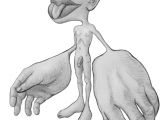1.Touch is not a sense, but a complex of senses. It is the last resort, when we want to be sure that the other senses have not cheated us, to see if what we see/hear/smell is really what it seems.
The touch comprises our whole body, and includes sensation of pain and temperature. Various senses linked to touch have various types of corpuscles or nervous terminations.
2.Touch allows to feel caressing, but also to assess size, shape, approximative weight, texture, temperature and whether they are painful or not without seeing them. Touch is also involved in orientation, especially with the eyes shut down.
Pain and temperature receptors alarm the brain much more rapidly than the brain can consciously, so that we retreat the hand from a hot surface before we get burned.
3.Skin's corpuscles are excited by changes in temperature and pressure. The sensitivity of a skin area is determined by the density of corpuscles and nervous terminations. The threshold for feeling two pressure points can be of just 1 mm on the tongue and 50 mm on the back.
4.Some corpuscles and terminations are more sensitive to specific excitations, but it seems that various sensations are determined rather by the model of the formed nervous impulses.
5.Free nervous terminations are located in the dermis (the skin's middle layer) while corpuscles in the hypodermis (the skin's deepest layer).
Specialized corpuscles are Krause (for cold), Ruffini (for heat), Vater-Pacini (for pressure) and Meissner (for light touch).
6.For humans, touch is crucial in expressing various feelings. For infants it has a major importance, because this is how they realize there is someone nearby taking care of them.
Touch sensations form in the somatosensory area of the brain's cortex. The sensations from the right part of the body go to the left cortex and vice versa. When the somatosensory area was mapped, it appeared that each part of the body had a specific zone, but the area of each zone did not correspond with the real proportions but with the sensitivity of an area. This is translated into a deformed human called "sensory homunculus".
The homunculus has much more developed (corresponding to touch sensitivity): genitalia, feet and toes, hand and fingers, lips and tongue.

 14 DAY TRIAL //
14 DAY TRIAL // 
